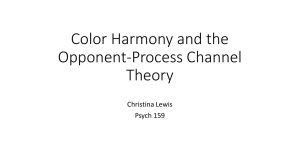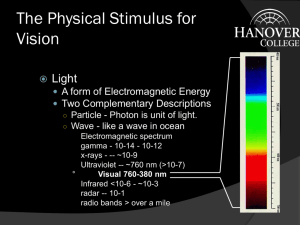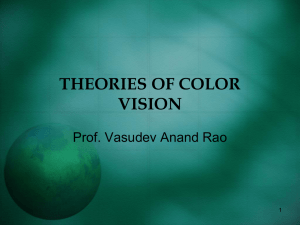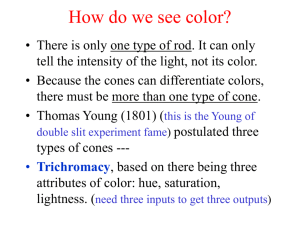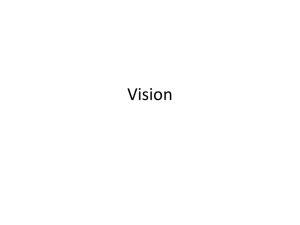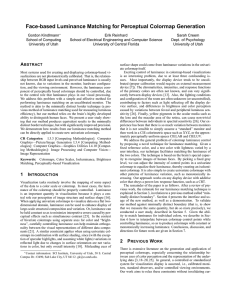Lecture 6: Color in Design
advertisement
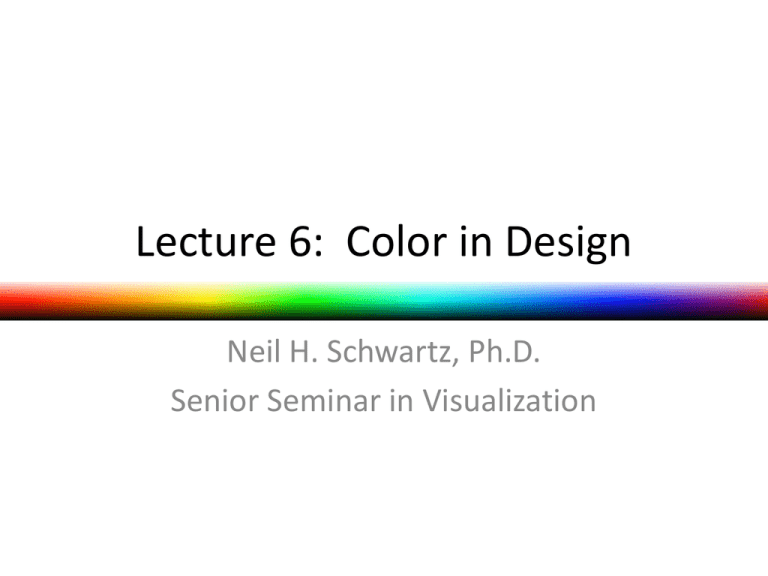
Lecture 6: Color in Design Neil H. Schwartz, Ph.D. Senior Seminar in Visualization Color-Processing in Vision Two Major Theories of Color Vision Trichromatic Theory Opponent-Process Theory Trichromatic Theory • Cone receptors process color. • There are 3 types of color-sensitive cones in the retina. Light Response Curve Peak responsivity Color-Processing in Vision Long wavelength Short wavelength BLUE CONES Light Response Curve Peak responsivity Height is unknown •2% OF THE CONE POPULATION •Found mostly outside the fovea •Blue cone sensitivity is equal to the others, so it must have a boosting mechanism. GREEN CONES •32% OF THE CONE POPULATION •Packed into the fovea centralis. How much of the particular part of the color spectrum is absorbed by the 3 types of cones. RED CONES •64% OF THE CONE POPULATION •Packed into the fovea centralis. Nanometers RED GREEN BLUE • Trichromatic Theory [RGB Cone excitation] does not explain how all color is seen. Why do we see an after-image of green, when looking at red? Opponent Process Theory • Color perception is controlled by the activity of three opponent systems: luminance only • Color perception works through a process of excitatory and inhibitory responses, with the two components of each mechanism opposing each other. – Red creates a positive (or excitatory) response while green creates a negative (or inhibitory) response. It is the difference that gives the color. – These responses are controlled by opponent neurons-neurons that have an excitatory response to some wavelengths and an inhibitory response to wavelengths in the opponent part of the spectrum. Which Theory Then? BOTH • The trichromatic theory explains color vision phenomena at the photoreceptor level. • The opponent-process theory explains color vision phenomena that result from the way photoreceptors are interconnected neurologically. Visual Properties of Opponent Process Theory Simultaneous Contrast • SC is a distortion of the appearance of a patch of color in a way that increases the difference between a color and its surroundings. • Two colors, side by side, interact with one another and change our perception accordingly. The effect of this interaction is called simultaneous contrast. Since we rarely see colors in isolation, simultaneous contrast affects our sense of the color that we see. Simultaneous Contrast • Simultaneous contrast is most intense when the two colors are complementary colors. • Sensation is the most intense where two extremes are juxtaposed. Simultaneous Contrast • This is called chromatic contrast when it occurs in the either the red-green or the yellow-blue channel. Simultaneous Contrast • This is called lightness or brightness contrast when it occurs in the black-white. (luminance) Simultaneous Contrast Contrast occurs because the visual system is better at determining differences between colors, rather than how much light is actually reflected. A magnificent website for simultaneous contrast and art. http://www.webexhibits.org/colorart/contrast.html There are functional benefits between Chromatic contrast and Luminance contrast Luminance contrast is better for showing 1. Detail 2. Motion 3.Stereoscopic depth 4. Determining shape from shading 5. The contrast must be at least 3:1 Color Detection & Identification The appearance of a color is affected by the colors that surround it, its orientation with respect to the source of light, whether it is perceived as being in or out of a shadow, the texture of the surface on which it lies, etc. Principles for Design: Color and Detail • When using color, luminance contrast is essential for showing detailed information. • As graphical features get larger, the need for extreme luminance contrast declines. • Luminance contrast is critical for small text. Principles for Design: Color Coding Information • The most important use of color is to indicate categories of information. • Two primary considerations are: • Visual distinctness • Learnability • With complex designs and small symbols, the limit of symbols = 12. • 6 – 12 symbols can be used in a symbol set. Principles for Design: Emphasis & Highlighting Principles for Design: Color Sequencing Principles for Design: Semantics of Color
